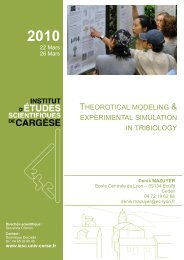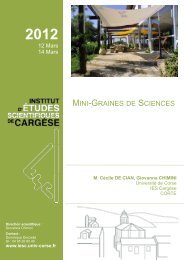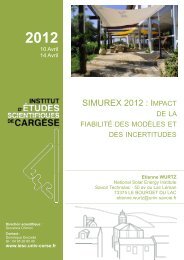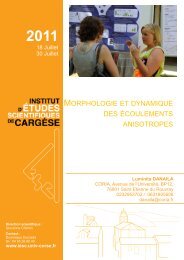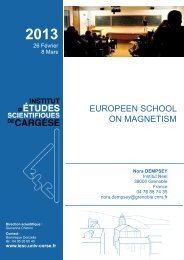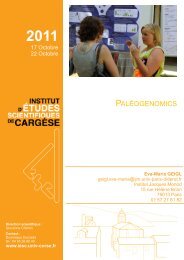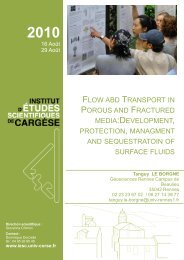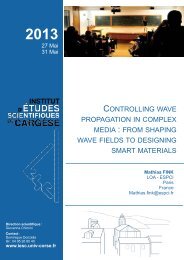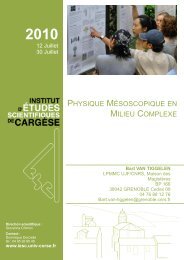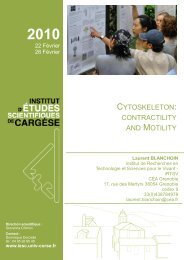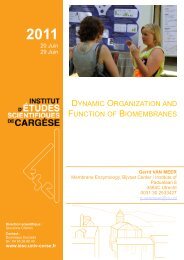nanoelectronics - Institut d'Études Scientifiques de Cargèse (IESC)
nanoelectronics - Institut d'Études Scientifiques de Cargèse (IESC)
nanoelectronics - Institut d'Études Scientifiques de Cargèse (IESC)
You also want an ePaper? Increase the reach of your titles
YUMPU automatically turns print PDFs into web optimized ePapers that Google loves.
Tuesday<br />
Tuesday, October 23<br />
Random-matrix theory of thermoelectricity<br />
Carlo Beenakker<br />
Instituut-Lorentz, Lei<strong>de</strong>n University, P.O. Box 9506, 2300 RA Lei<strong>de</strong>n, The Netherlands<br />
Since Landauer, Büttiker, and Imry’s work in the 1980’s we know that the study of electrical<br />
conductance in mesocopic systems is related to the study of the statistical properties of<br />
scattering matrices. Random-matrix theory was <strong>de</strong>veloped as a powerful tool to make<br />
universal predictions, in<strong>de</strong>pen<strong>de</strong>nt of microscopic <strong>de</strong>tails of the system. Thermoelectric<br />
transport properties typically involve energy <strong>de</strong>rivatives of the conductance, and one might<br />
won<strong>de</strong>r whether random-matrix theory can play an instructive role as well. The relevant<br />
matrix is the socalled time-<strong>de</strong>lay matrix, which contains dynamical information on the<br />
electron scattering. We review some ol<strong>de</strong>r work on the random-matrix theory of<br />
thermoelectricity, and also some recent work on thermal conduction in topological<br />
superconductors.<br />
General background material: ArXiv:0904.1432<br />
__________________________________________________________________________<br />
Thermoelectric Properties of Semiconductor Nanostructures<br />
Laurens W. Molenkamp<br />
Physikalisches <strong>Institut</strong> (EP3) <strong>de</strong>r Universität Würzburg, Am Hubland, 97074 Würzburg<br />
Thermoelectric experiments on nanostructures are often complicated by the need to apply a<br />
temperature difference of a few K across a <strong>de</strong>vice a few 100 nm in size. In semiconductors,<br />
such large gradients lead to very strong phonon drag effects, that overwhelm the electronic<br />
thermoelectric effects a transport physicist usually is interested in.<br />
Over the years, we have <strong>de</strong>veloped a current heating technique that utilizes the relatively<br />
small electron-acoustic phonon coupling in semiconductors to create a thermal gradient in<br />
the electronic system only. This has allowed us to study in <strong>de</strong>tail the thermoelectric<br />
properties of quantum point contacts and quantum dots. More recently, we have started to<br />
apply the technique to spintronic nanostructures. In this talk, I will present some of our recent<br />
results in this direction, with examples such as the thermoelectric properties of a dot in the<br />
Kondo regime, thermal rectification and the diffusion thermopower of (Ga,Mn)As.



